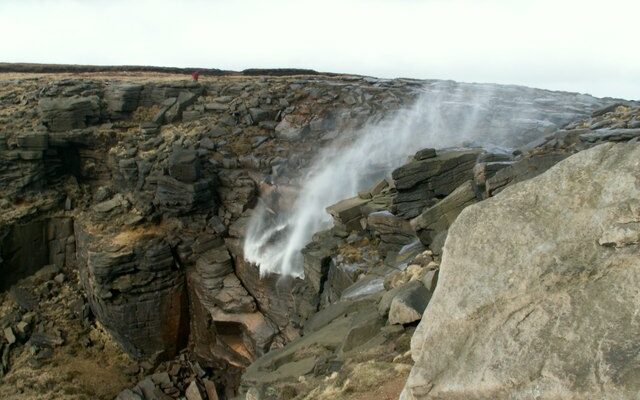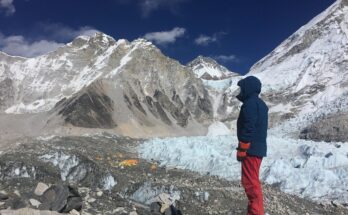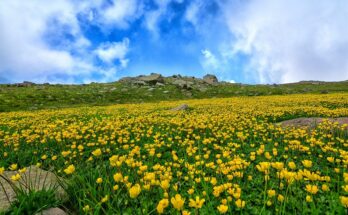The monsoon season brings with itself the birth of several waterfalls across the world and provides more water to the already existing ones. It is very common to see the water flowing from an uphill region down to the valley below but have you ever come across a gravity defying waterfall where the direction of the water fall is reversed? These extremely rare waterfalls are known as reverse waterfalls and these can be found only in a few places in the world.
Reverse waterfalls are actually temporary because they are a phenomenon that occur in places which experience strong winds. In places where the waterfalls receive a large volume of water along with very strong winds, the wind pushes the falling water backwards which results in an upward rising mist spray that blows over a large area. This is an upside down waterfall or a reverse waterfall. It is an interesting phenomenon that one can witness in a few parts of the world when the conditions are right. It is truly a delight to watch this phenomenon and capture it with a camera. Here are a few places in the world where you can witness the phenomenon of reverse waterfall.
Royal National Park, Sydney, Australia
Two years ago, the people of Sydney were taken by surprise when they witness a few waterfalls in reverse direction at Royal National Park. This event gained the attention of the media worldwide. The area received heavy torrential rain leading to increase in volume of the waterfalls which was followed by strong winds blowing at the speed of 70 km/hour at the cliffs which lead to the water flowing upwards. The string winds came from the ocean and hit the cliffs with such force that the water that was supposed to fall down was pushed upwards.
Cliffs of Moher, Ireland
On an ordinary day, the Cliffs of Moher on the western coast are scenic and provide you with dramatic views of the ocean. However, during the monsoons, these cliffs that stretch for around five miles, are dotted with waterfalls which directly fall into the ocean. In a rare phenomenon that occurred in the year of 2019, the waterfalls that formed during the rains met the fierce winds from the Atlantic Ocean and were forced to move backwards and upward creating a reverse direction waterfall. A few people were lucky to witness it in person, while others enjoyed the spectacular sight by watching the videos created by the people.
Naneghat, Maharashtra, India
One of the best places to witness the phenomenon of reverse waterfall in India is Naneghat Maharashtra. Located in the Western Ghats, a few hours away from Pune, the highland cliffs of Naneghat become alive with greenery after the monsoon season. The waterfalls are heavy with rainwater and the fierce winds hitting the high cliffs force the falling waters away from their natural trajectory in an upwards spray of mist. The late monsoons attract a lot of tourists to Naneghat, most of whom just come here to witness these beautiful reverse waterfalls.
Waipuhia Falls, Oahu, Hawaii
Hawaii is a place which is full of natural beauty and one of the most spectacular natural wonder is the amazing waterfalls of Waipuhia that can be viewed from the Pali expressway in Oahu. Also known as the Upside Down Waterfall, the Waipuhia Falls flow over a cliff on Mount Konahuanui. But before they can reach the ground they are met with the powerful north easterly trade winds that catches the water and forces it up the walls of the cliff creating an illusion of water flowing in the upwards direction. This view can be seen only after heavy rains in the presence of string winds and one can notice it while driving along in the highway.
Rjúkandi Waterfall, Iceland
Rjúkandi Waterfall in Iceland is a spring fed waterfall that is located in the Eyjafjöll mountain range in South Iceland. This region in Iceland is known to be one of the windiest places of Iceland. The strong winds cause the Rjúkandi Waterfalls to flow in the upward direction creating a reverse waterfall. This has become a common occurrence over the last few years and can be viewed from the highway Route One when the winds are strong.
Furepe Falls, Japan
The Furepe Falls in Japan is a popular tourist attraction that is located in the Shiretoko National Park and this cascade flows over a steep cliff and falls into the Sea of Okhotsk. In a rare phenomenon, when the region receives heavy rainfall and experiences string winds, the waters of this cascade gets reversed and flows in the opposite direction creating a reverse waterfall. It is truly a beautiful sight to behold during the rare occasion when it takes place.
Amboli, Belgaum, India
The Western Ghats of India are one of the best places to witness the phenomenon of reverse waterfalls during the late monsoons. The Amboli Hills in the Western Ghats near Belgaum are dotted with several waterfalls that form during the monsoon season and are one of the best places to witness a reverse waterfall in the presence of strong winds. The Kavalshet Point is a great place to witness it and it has paved path with railing for visitors. One needs to be careful for this path becomes slippery due to the constant spray of water.
Kinder Downfall, England
Located in the Peak District of England, the Kinder Downfall is a popular spot where the phenomenon of reverse waterfall occurs. This waterfalls cascades down a steep cliff which is about 80 feet high. When this area is hit by high speed winds, it updrafts the falling water causing it to blow back upstream creating a reverse waterfall. The mist created by this reverse waterfall can be seen from several miles away.
Maule River, Chile
The Maule River in Chile flows over the cliffs in the region of Talca. This region in central Chile often experiences strong winds causing the waters of the Maule River to flow upwards in the reverse direction creating a reverse waterfall. This phenomenon is quite common in the Maule region and attracts a lot of tourists.
Smoke Waterfalls, Brazil
The Cachoeira da Fumaça also known as the Smoke Waterfall is located in the Chapada Diamantina National Park in Brazil. The waters of this cascade flow down at least 1100 feet through craggy rocks creating a mist that gives them the name. However, when they encounter strong winds, these mists are forced upwards where the water rises in plumes creating a reverse waterfall. This can be viewed by tourists who visit the National Park.




